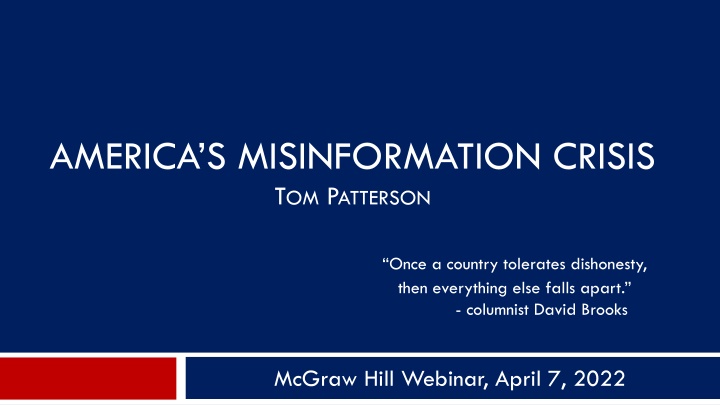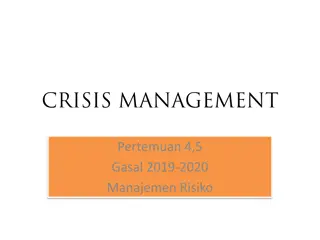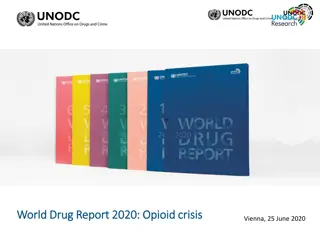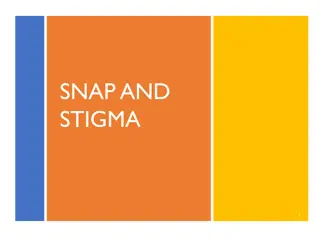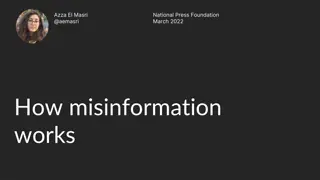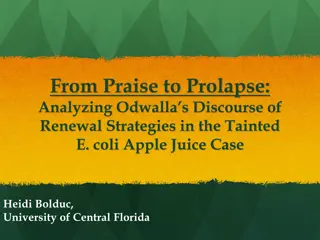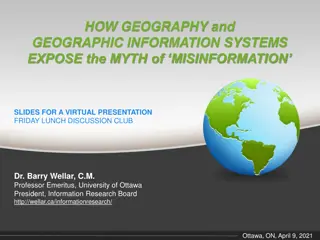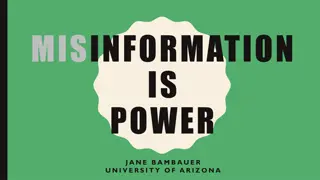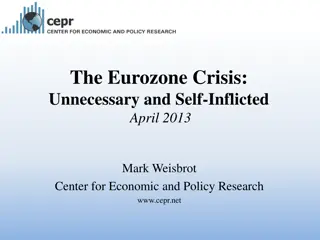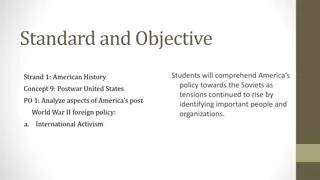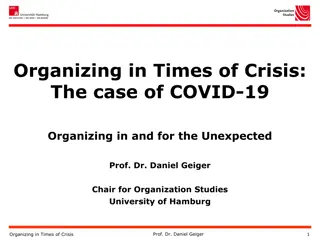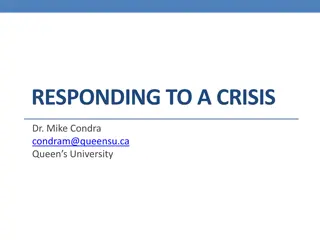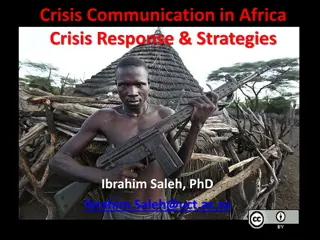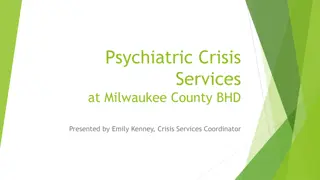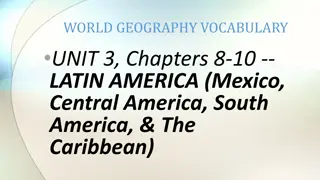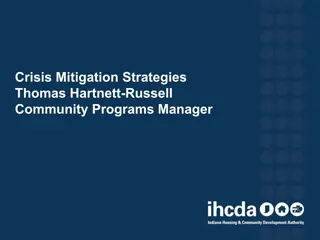AMERICA’S MISINFORMATION CRISIS
Once a country tolerates dishonesty, everything else falls apart. Explore the rise of misinformation, the impact of party polarization, and media changes. Learn about misinformation vs. disinformation, and why addressing this crisis is crucial in today's society.
Download Presentation

Please find below an Image/Link to download the presentation.
The content on the website is provided AS IS for your information and personal use only. It may not be sold, licensed, or shared on other websites without obtaining consent from the author.If you encounter any issues during the download, it is possible that the publisher has removed the file from their server.
You are allowed to download the files provided on this website for personal or commercial use, subject to the condition that they are used lawfully. All files are the property of their respective owners.
The content on the website is provided AS IS for your information and personal use only. It may not be sold, licensed, or shared on other websites without obtaining consent from the author.
E N D
Presentation Transcript
AMERICAS MISINFORMATION CRISIS TOM PATTERSON Once a country tolerates dishonesty, then everything else falls apart. - columnist David Brooks McGraw Hill Webinar, April 7, 2022
WE THE PEOPLE, 14e NUMBER ONE in American Government To obtain a free instructor s copy of We the People, please enter your name and affiliation in the Chat Room. Accessibility through Readability Critical Thinking Emphasis Case Studies & Pedagogy Even-handed approach with broad appeal Unparalleled Instructor Support 24 Complimentary HarvardX/EdX Video Lectures
AMERICAS MISINFORMATION CRISIS TOM PATTERSON Once a country tolerates dishonesty, then everything else falls apart. - columnist David Brooks McGraw Hill Webinar, April 7, 2022
Todays Session Rise in Misinformation Explain the rise, including role of party polarization and media change What we can do to deflate it
Definitions Misinformation: False information that is held or spread, regardless of intent. Disinformation: False information that is spread with intent to deceive.
But conditions have changed that make misinformation a much larger problem Demand Side: Although human psychology hasn t changed, party polarization has heightened demand for misinformation & increased our vulnerability to it Supply Side: Rise of partisan and social media and breakdown of norms against deception have sharply increased supply of misinformation
COVID-19 The biggest public health failure in our history US death rate Canadian death rate If US had Canada s death rate, more than 600,000 deceased Americans would be alive today Why did we perform so poorly? 295/100,000 99/100,000 Source: Johns Hopkins/World Bank data
It wasnt for reason of medical science or facilities Per capita, U.S. has world s largest number of ICU & hospital beds Since the 1918 Spanish flu, masking and social distancing have been the first line of defense against an outbreak of an airborne virus. Mask wearing cuts infection rate in half, combined with social distancing it s a four-fold decrease. US had one of earliest supplies of reliable Covid vaccines
It was a compliance problem mask wearing three months into pandemic Is it very important to wear a mask when people go out in public? (percentage of respondents) Large numbers also regarded social distancing as unnecessary No/not clear 52 Yes 48 Source: Pew Research Center poll, June 2020
It was a compliance problem percentage of total population fully vaccinated 77 Canada 81 68 65 55 60 55 48 United States 13 3 Mar-21 Jun-21 Sep-21 Canada Dec-21 Mar-22 U.S. Sources: U.S. Centers for Disease Control; Public Health Agency of Canada
Americans Hold a Lot of False Beliefs Index of Public Misperceptions About Politics and Society Sweden Germany Based on responses to 28 factual questions South Korea Japan Great Britain Poland Spain Canada Belgium Australia France USA Italy 0 20 40 60 80 100 Source: IPSOS Survey, 2017
Examples of recent factual claims Donald Trump faked having Covid-19 in order to win sympathy votes Joe Biden is mentally impaired Dr. Anthony Fauci funded a lab in Wuhan to develop the coronavirus If reelected, Donald Trump planned to eliminate social security and Medicare Kamala Harris was not born in United States CDC manipulated numbers to exaggerate number of dead from Covid-19 President Trump went to the hospital while president after suffering a stroke Vote counting machines overcounted the Biden vote
None are true, but each is believed by tens of millions of Americans percentage of respondents saying statement is true Trump cut soc sec 48 Biden mentally impaired 45 Vote machines rigged 43 CDC faked Covid 42 Trump faked Covid 41 Trump had stroke 31 Fauci funded Wuhan 27 Harris not a citizen 27 Source: Indiana University s Observatory on Social Media survey, November 2020
Explaining Rise in Misinformation Party Polarization
Our partisan divide ideological polarization Ideological position of median voter Conservative median Republican median Democrat Liberal 1994 2011 2017 Source: Derived from Pew Research Center s polls
Our partisan divide affective polarization percentage of respondents How Republicans see Democrats "enemies" 57 "opponents" 43 How Democrats see Republicans "enemies" 41 "opponents" 59 Source: CBS News poll, February, 2021
Why Polarization Matters Party polarization heightens: Cue-taking (heuristic shortcuts ) Our tendency to accept at face value claims made by our party leaders and by like-minded media sources and reject those coming from other side. Confirmation Bias: Our psychological tendency to interpret claims in ways that confirm our preexisting partisan beliefs and biases. Motivated Reasoning: Our biases lead us to conclusions based on their desirability (whether they fit with what we would prefer) rather than on what the evidence would indicate.
Heuristic: Cue Taking Example Percentage of Republicans expressing support for US missile strikes against Syria in response to Bashar al-Assad using chemical weapons against civilians 87 22 2013 2017 Source: Washington Post/ABC News polls, 2013 and 2017.
Another Heuristic - Familiarity Why Repetition Matters Accurate Claim False Claim percentage thinking claim is "accurate" percentage thinking claim is "accurate" 90 59 49 26 unfamiliar familiar unfamiliar familiar Source: Gordon Pennycook, presentation at Fake News Conference, Harvard, February 17, 2017.
Confirmation Bias example Of the 34 election presidential debates . . . debate winner according to post-debate polls 34 32 2 0 Republicans Republican candidate Democrats Democratic candidate Source: Multiple polls, estimated for some on incomplete data
motivated reasoning example Kahan, et al Yale study- In first experiment, subjects were given a somewhat difficult math test involving quantities of skin cream. Subjects with higher math skill, regardless of ideology, were more likely than those of lower skill to get the right answer. In follow-up experiment, subjects were given similarly difficult math tests involving effect of gun control on level of community violence. Liberals with high math skill scored high only when solution showed that gun control reduced violence. Conservatives with high math skill scored high only when solution showed that it didn t.
Governors as Cue-Givers - Covid-Based Restrictions on Social Gatherings Time lapse since first reported community transmission in US Study also found Democratic governors were quicker to close schools, issue stay-at-home orders, close non-essential businesses & issue mask mandates 3 15 days or less 1 15 16-20 days 7 6 more than 21/none 18 Democratic governor Republican governor Source: Christopher Adolph, et al, Pandemic Politics: Timing State-Level Social Distancing Responses to COVID-19, Journal of Health Politics, Policy and Law, August 2020, pp. 1-17.
Partisan responses to Covid in first months Would you feel comfortable attending a crowded party? Would you feel comfortable eating out in a restaurant? percentage of respondents percentage of respondents 65 31 29 28 11 16 8 7 March Democrats June March Democrats June Republicans Republicans Source: Pew Research Center poll, June 2020
Partisan Response to Covid in First Months Did you wear mask when outside home in last week (percent yes )? 98 93 Democrats 66 63 61 Republicans 42 April May June Source: Gallup polls, 2020
Confirmation Bias affects Republicans & Democrats alike - accepting false claims that align with one s partisanship 57 Trump faked Covid 17 47 Trump had stroke 16 Democrats Republicans 46 Trump cut soc sec 6 19 Fauci paid Wuhan 34 12 Harris not citizen 38 19 CDC faked Covid 54 23 Vote machines rigged 76 Biden mentally impaired 22 82 Source: Indiana University s Observatory on Social Media survey, November 2020
Explaining Our Misinformation Crises Changes in Media System
The Old Low Choice System Low Choice In most media markets, consumers seeking national news had local newspaper and a network newscast (ABC, CBS, NBC) as their only options. Media effects: 1. An information commons 2. Rising level of information 3. Depolarization
Today High Choice System Traditional news outlets Cable news and talk shows CNN, Fox, and MSNBC Talk radio ten-fold increase following elimination of Fairness Doctrine, weekly audience is roughly 40 million listeners Internet news outlets (eg, HuffPost, Breitbart), bloggers, social media activists
Our Media System Traditional (fact verifying) outlets, such as CBS News, and the Chicago Tribune, that have norms and editing procedures designed to reduce factual reporting errors and correct them when they occur. Partisan (bias confirming) outlets, such as Fox and Breitbart, that tell their audience what they expect/want to hear. These are dominant tendencies. Some traditional outlets have a bias-confirming component (eg, opinion page of traditional newspapers) and some partisan outlets have a fact-verifying component (eg, Fox s Special Report with Bret Baier).
Fact Verifying Does Not Mean Unbiased CBS Evening News 2020 Election Fox Special Report w/Brett Baier 2020 Election percentage of Trump coverage percentage of Trump coverage 26 14 28 86 74 12 Covid economy other issues Covid economy other issues Source: Thomas E. Patterson, A Tale of Two Elections, Shorenstein Center, Harvard University, December 17, 2020
Fact Verifying Does Not Mean Unbiased CBS Evening News 2020 Election Fox Special Report-Brett Baier 2020 Election Percentage of Trump s coverage Percentage of Trump s coverage 95 64 Covid Covid 5 36 67 7 economy economy 33 93 negative positive negative positive Source: Thomas Patterson, analysis of Media Tenor data, March 1-November 3, 2020
Another feature of our media system strong links only among like types of media Outlets on the partisan side are fewer and overwhelmingly conservative in orientation Traditional Partisan Source: Benkler, et al, Network Propaganda (New York: Oxford University Press, 2018)
Ideological Asymmetry- Information Sharing by Party Identification Information sharing about Covid on Twitter Democrats relied heavily to traditional media rather than partisan media when sharing a piece of content through Twitter ratio was 163 to 1 Republicans tilted only slightly to traditional media as opposed to partisan media ratio was 1.16 to 1 Source: Sebastian Blum, Master s thesis, Harvard University, 2022.
BUT Republicans and Democrats are alike in type of content they share/like percentage of respondents who respond favorably to a political tweet depending on whether it s supportive of their partisanship Republicans Supporitve 15 Unsupportive 5 Democrats Supportive 15 Unsupportive 5 Source: David Rand, et al, Shared Partisanship Dramatically Increases Social Tie Formation in a Twitter Field Experiment, Proceedings of the National Academy of Sciences, 2021.
Another Tendency Sorting on Partisan Media: percentage of partisans who say outlet is a main source of news 6 Fox 93 95 MSNBC 5 Democrats Republicans Source: Pew Research Center poll, 2019
Political Blogosphere much smaller audience but far more partisan Political orientation of top 25 blogs Over 90 percent of links on political blogs/websites link to sites that cater to the same beliefs. 1 11 13 Middle of road Liberal Conservative
Sources of Misinformation Partisan Media Partisan talk shows/websites are filled with disinformation Based on a study of more than four million media messages, Yochai Benchler et al concluded that partisan media are distinctive for their disinformation, lies, and half-truths. Sources: Benchler, et al, Network Propaganda; New York Times, November 13, 2020 (based on MIT s RadioSpeak data)
Most Conservative Talk Shows Were Dismissive of the Covid Threat It s no worse than the common cold, folks, Rush Limbaugh It s a great time to fly. Healthy people, generally, 99 percent recover very fast, even if they contract it. . . Put it in perspective: 26 people were shot in Chicago alone over the weekend. I doubt you heard about it. You notice there s no widespread hysteria about violence in Chicago. Laura Ingraham Sean Hannity
Conservative talk-show viewers/listeners perception of pandemic percentage of conservative talk show listeners/viewers Has the pandemic been made out to be a bigger deal than it actually is? yes 78 no 3 Source: Pew Research Center survey, September 2020.
Covid Misinformation and Media Exposure 3 2.8 Level of misinformation 2.6 2.4 partisan media 2.2 2 1.8 traditional print media 1.6 1.4 1.2 1 0 1 2 3 4 5 Level of exposure low to high Source; Kathleen Hall Jamieson, The Relation between Media Consumption and Misinformation at the Outset of the SARS-CoV-2 Pandemic in the US, Harvard Kennedy School Misinformation Journal, April 2020.
Vaccination Rate by News Outlet Percentage with first dose of vaccine by main news source 83 CNN, MSNBC 79 74 71 74 ABC, CBS, NBC NPR/PBS 66 FOX 62 61 May-21 Jul-21
Sean Hannity-Tucker Carlson Study Study examined two audiences - Audience for Hannity, who downplayed the threat Audience for Carlson, who said threat was serious Survey finding: On average, Carlson audience members adopted protective behavior much earlier than Hannity audience members Epidemiological finding: U.S. counties with higher audience ratings for Hannity had higher death and hospitalization rates than other counties. Source: Leonardo Bursztyn, Aakaash Rao, Christopher Roth, and David Yanagizawa-Drott, Misinformation During a Pandemic, University of Chicago, September 2020.
Bloggers & Malicious Actors primary source of fake news
The Power of Fake to Attract Our Attention relative speed with which a story travels on social media. Actual news story 1.00 On average, fake stories travel six times faster on social media than true stories Fake news story 6.00 Source: Soroush Vosoughi, Deb Roy, and Sinan Aral, The spread of true and false news online, Science 369 (2018): 1146-1151.
Super Spreaders of Fake News Extreme liberals and extreme conservatives are far more likely than other citizens to share fake news stories. Source: Toby Hopp, et al, Why Do People Share Ideologically Extreme, False, and Misleading Content on Social Media? Human Communication Research (2020).
Traditional media are fact checkers but also a leading source of misinformation News organizations play a major role in propagating hoaxes, false claims, questionable rumors, and dubious viral content. Craig Silverman, et al, Lies, Damn Lies and Viral Content, Columbia University, February 10, 2015. Although traditional news outlets don t ordinarily twist the facts, they report the words of political leaders who do shade the truth over 80 percent of false claims are disseminated without mention that they re inaccurate.
The News Media and Trump s Tweets A NY Times fact check found that a third of Trump s tweets contained a significant falsehood. How did Americans learn of Trump s tweets? 1% directly from his Twitter feed 99% directly or indirectly through the media Sources: Fact check, https://www.nytimes.com/2020/06/03/us/politics/trump-twitter-fact-check.html; tweet exposure, http://www.newsweek.com/trump-tweets-one-percent-mainstream-media-769207
